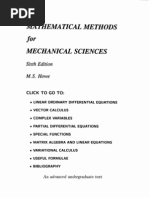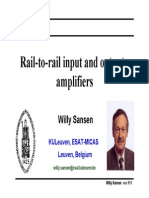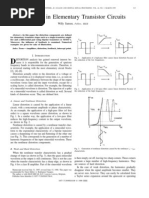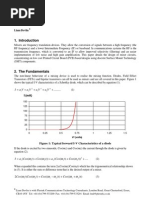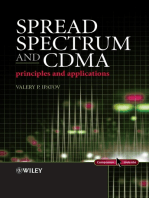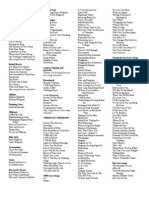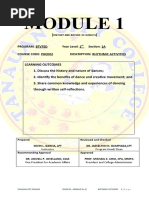Noise Notes
Noise Notes
Uploaded by
Raj AnCopyright:
Available Formats
Noise Notes
Noise Notes
Uploaded by
Raj AnCopyright
Available Formats
Share this document
Did you find this document useful?
Is this content inappropriate?
Copyright:
Available Formats
Noise Notes
Noise Notes
Uploaded by
Raj AnCopyright:
Available Formats
Analog
Communication
Suresh P. Nair [AIE, ME, (PhD)] MIEEE
Professor & Head
Department of Electronics and Communication Engineering
Royal College of Engineering and Technology
Chiramanangad PO, Akkikkavu, Thrissur, Kerala, India
P. Suresh Venugopal 2 Analog Communication - NOISE
Topics to be covered
Noise
Sources of noise
Thermal Noise, Shot Noise, Flicker noise and White noise
Noise Parameters
Signal to noise ratio
Noise factor
Noise equivalent band width
Effective noise temperature
P. Suresh Venugopal 3 Analog Communication - NOISE
Topics to be covered
Narrow band noise
Representation of narrowband noise in terms of In
phase and Quadrature Components
Noise in CW modulation Systems
Noise in linear Receivers using Coherent detection
Noise in AM Receivers using Envelope detection
Noise in FM Receivers
P. Suresh Venugopal 4 Analog Communication - NOISE
Noise Sources
Introduction to Noise
Shot Noise
Thermal Noise
Flicker Noise
White Noise
P. Suresh Venugopal 5 Analog Communication - NOISE
Noise - Introduction
Noise Unwanted Signals that tend to disturb the
Transmission and Processing of Signals in
Communication System and over which we have
incomplete control.
Noise is a general term which is used to describe
an unwanted signal which affects a wanted signal.
These unwanted signals arise from a variety of
sources.
P. Suresh Venugopal 6 Analog Communication - NOISE
Sources of Noise
Sources of noise may be:
External
Internal
Naturally occurring external noise sources include:
Atmosphere disturbance (e.g. electric storms, lighting,
ionospheric effect etc), so called Sky Noise
Cosmic noise which includes noise from galaxy, solar
noise
Hot spot due to oxygen and water vapour resonance
in the earths atmosphere.
P. Suresh Venugopal 7 Analog Communication - NOISE
Sources of Noise
Noise performance by external sources is shown
below.
Sources of Noise
Internal Noise is an important type of noise that
arises from the SPONTANEOUS FLUCTUATIONS of
Current or Voltage in Electrical Circuits.
This type of noise is the basic limiting factor of
employing more complex Electrical Circuits in
Communication System.
Most Common Internal Noises are:
Shot Noise
Thermal Noise
P. Suresh Venugopal 9 Analog Communication - NOISE
Shot Noise
Shot Noise arises in Electronic Components like
Diodes and Transistors.
Due to the discrete nature of Current flow In
these components.
Take an example of Photodiode circuit.
Photodiode emits electrons from the cathode
when light falls on it.
The circuit generates a current pulse when an
electron is emitted.
P. Suresh Venugopal 10 Analog Communication - NOISE
Shot Noise
The electrons are emitted at Random times,
k
where - < k < and assume this random
emission have been gone for a long time.
Thus the Total Current flowing through the
Photodiode may be modeled as the sum of these
Current Pulses.
This process X(t) is Stationary and is called SHOT
NOISE
P. Suresh Venugopal 11 Analog Communication - NOISE
Thermal Noise
Thermal Noise is the name given to the Electrical Noise arising
from the Random motion of electrons n a conductor.
It is also called Jonson Noise or Nyquist Noise.
Let V
TN
is the Thermal Noise Voltage appearing across the two
terminals of a resistor.
Let the applied voltage have a bandwidth or frequency), f.
Then the Mean Square value of V
TN
is given by:
P. Suresh Venugopal 12 Analog Communication - NOISE
Thermal Noise
Where
k = Boltzmanns constant = 1.38 x 10
-23
Joules per
o
K
T = absolute temperature in
o
K
R = resistance in ohms
P. Suresh Venugopal 13 Analog Communication - NOISE
Jonson Noise or Nyquist Noise
P. Suresh Venugopal 14 Analog Communication - NOISE
Thermal Noise
We can model a noisy resistor using the Thevenin and
Norton Equivalent Circuit as shown below:
Thermal Noise
The number of electrons inside a resistor is very
large and their random motions inside the
resistors are statistically independent.
The Central Limiting Theorem indicates that
thermal Noise is a Gaussian Distribution with Zero
mean.
P. Suresh Venugopal 16 Analog Communication - NOISE
Low Frequency or Flicker Noise
Active devices, integrated circuit, diodes, transistors etc also
exhibits a low frequency noise, which is frequency
dependent (i.e. non uniform) known as flicker noise .
It is also called one over f noise or 1/f noise because of
its low-frequency variation.
Its origin is believed to be attributable to contaminants and
defects in the crystal structure in semiconductors, and in
the oxide coating on the cathode of vacuum tube devices
P. Suresh Venugopal 17 Analog Communication - NOISE
Low Frequency or Flicker Noise
Flicker Noise is found in many natural phenomena such as
nuclear radiation, electron flow through a conductor, or
even in the environment.
The noise power is proportional to the bias current, and,
unlike Thermal and Shot Noise, Flicker Noise decreases with
frequency.
An exact mathematical model does not exist for flicker
noise because it is so device-specific.
However, the inverse proportionality with frequency is
almost exactly 1/f for low frequencies, whereas for
frequencies above a few kilohertz, the noise power is weak
but essentially flat.
P. Suresh Venugopal 18 Analog Communication - NOISE
Low Frequency or Flicker Noise
Flicker Noise is essentially random, but because its frequency
spectrum is not flat, it is not a white noise.
It is often referred to as pink noise because most of the power is
concentrated at the lower end of the frequency spectrum.
Flicker Noise is more prominent in FETs (smaller the channel length,
greater the Flicker Noise), and in bulky carbon resistors.
The objection to carbon resistors mentioned earlier for critical low
noise applications is due to their tendency to produce flicker noise
when carrying a direct current.
In this connection, metal film resistors are a better choice for low
frequency, low noise applications.
P. Suresh Venugopal 19 Analog Communication - NOISE
White Noise
The Noise Analysis of Communication System is
done on the basis of an idealized form of noise
called WHITE NOISE.
Its power spectral density is independent on
operating frequency.
White White light contain equal amount of all
frequencies in visible spectrum.
P. Suresh Venugopal 20 Analog Communication - NOISE
White Noise
Power spectral density is given by:
The 1/2 here emphasizes that the
spectrum extends to both positive
and negative frequencies.
P. Suresh Venugopal 21 Analog Communication - NOISE
Power Spectral Density of White
Noise
A random process W(t) is called white noise if it
has a flat power spectral density, i.e., S
W
(f) is a
constant c for all f.
P. Suresh Venugopal 22 Analog Communication - NOISE
Ideal Low Pass Filtered White
Noise
Let
w(t) = White Gaussian Noise applied to the LPF
B = Bandwidth of LPF
n(t) = noise appearing at the output of LPF
S
N
(f) = Power Spectral Density of n(t)
R
N
() = Auto Correlation function of n(t)
P. Suresh Venugopal 23 Analog Communication - NOISE
Ideal Low Pass filtered White
Noise
P. Suresh Venugopal 24 Analog Communication - NOISE
Noise Parameters
Signal to noise ratio
Noise factor
Noise equivalent band width
Effective noise temperature
P. Suresh Venugopal 25 Analog Communication - NOISE
Signal to Noise Ratio (SNR)
where: P
S
is the signal power in watts
P
N
is the noise power in watts
Hartley-Shannon Theorem (also called Shannons Limit)
states that the maximum data rate for a communications
channel is determined by a channels bandwidth and SNR.
A SNR of zero dB means that noise power equals the
signal power.
|
|
.
|
\
|
=
N
S
10
P
P
log 10 dB SNR
P. Suresh Venugopal 26 Analog Communication - NOISE
Noise Figure / Factor (NF or F or F
n
)
Electrical noise is defined as electrical energy of
random amplitude, phase, and frequency.
It is present in the output of every radio receiver.
The noise is generated primarily within the input
stages of the receiver system itself.
Noise generated at the input and amplified by the
receiver's full gain greatly exceeds the noise
generated further along the receiver chain.
P. Suresh Venugopal 27 Analog Communication - NOISE
Noise Figure / Factor (NF or F or F
n
)
The noise performance of a receiver is described
by a figure of merit called the noise figure (NF).
where G = Antenna Gain
P. Suresh Venugopal 28 Analog Communication - NOISE
Noise equivalent band width
P. Suresh Venugopal 29 Analog Communication - NOISE
Effective noise temperature
T = environmental temperature (Kelvin)
N = noise power (watts)
K = Boltzmanns constant (1.38 10
-23
J/K)
B = total noise factor (hertz)
T
e
= equivalent noise temperature
F = noise factor (unitless)
P. Suresh Venugopal 30 Analog Communication - NOISE
N
T
KB
=
( )
1
e
T T F =
1
e
T
F
T
= +
Narrowband
Noise
Introduction to Narrowband Noise
Representation of narrowband noise in terms of
In phase and Quadrature Components
P. Suresh Venugopal 31 Analog Communication - NOISE
Narrow band noise
Preprocessing of received signals
Preprocessing done by a Narrowband Filter
Narrowband Filter Bandwidth large enough to
pass the modulated signal.
Noise also pass through this filter.
The noise appearing at the output of this NB filter
is called NARROWBAND NOISE.
P. Suresh Venugopal 32 Analog Communication - NOISE
Narrow band noise
Fig (a) spectral components of NB Noise concentrates about +f
c
Fig (b) shows that a sample function n(t) of such process appears
somewhat similar to a sinusoidal wave of frequency f
c
Narrow band noise
We need a mathematical representation to analyze the
effect of this NB Noise.
There are 2 specific representation of NB Noise
(depending on the application)
P. Suresh Venugopal 34 Analog Communication - NOISE
Representation of narrowband noise in
terms of In phase and Quadrature
Components
Let n(t) is the Narrowband Noise with Bandwidth
2B centered at f
c
We can represent n(t) in canonical (standard) form
as:
We can extract n
I
(t) (In Phase Component) and
n
Q
(t) (Quadrature Component) from n(t).
P. Suresh Venugopal 35 Analog Communication - NOISE
Extraction of n
I
(t) and n
Q
(t) from
n(t)
Each LPF have bandwidth B
This is known as NARROWBAND NOISE ANALYSER
Generation of n(t) from n
I
(t) and
n
Q
(t)
This is known as NARROWBAND NOISE SYNTHESISER
P. Suresh Venugopal 37 Analog Communication - NOISE
Important properties of n
I
(t) and
n
Q
(t)
Important properties of n
I
(t) and
n
Q
(t)
P. Suresh Venugopal 39 Analog Communication - NOISE
Noise in CW modulation
Systems
Noise in linear Receivers using Coherent detection
Noise in AM Receivers using Envelope detection
Noise in FM Receivers
P. Suresh Venugopal 40 Analog Communication - NOISE
Gaussian process
Let X(t) denote a random process for an interval that starts at
time t = 0 and lasts until t = T.
The random variable Y is a linear functional of the random
process X(t) if:
where g(t) is an arbitrary function
By definition:
The random process X(t) is a Gaussian process if every linear
functional of X(t) is a Gaussian random variable.
P. Suresh Venugopal 41 Analog Communication - NOISE
Main virtues of the Gaussian process:
Gaussian process has many properties that make results
possible in analytic form
Random processes produced by physical phenomena (see
thermal noise as an example) are often such that they
may be modeled by the Gaussian process
If the input to a linear time invariant (LTI) system is
Gaussian then its output is also Gaussian
P. Suresh Venugopal 42 Analog Communication - NOISE
Thermal noise
Is generated by each resistor.
Used to model channel noise in analysis the of
communication systems.
It is an ergodic, Gaussian process with the
mean of zero.
P. Suresh Venugopal 43 Analog Communication - NOISE
Gaussian distribution
Main virtue of the Gaussian process:
Two parameters, the mean and variance are enough
to fully characterize a Gaussian distribution.
P. Suresh Venugopal 44 Analog Communication - NOISE
Power spectral density (PSD) of a
random process
By definition, the power spectral density S
X
(t) and autocorrelation
function R
X
() of an ergodic random process X(t) form a Fourier
transform pair with and f as the variables of interest.
The power of an ergodic random process X(t) is equal to the total
area under the graph of power spectral density.
The power spectral density is that characteristic of a random
process which is easy to measure and which is used in
communication engineering to characterize noise.
45
White Gaussian Noise
Gaussian means Gaussian process.
A measurable consequence: Measured instantaneous values of a
thermal noise give a Gaussian distribution.
White means that the autocorrelation function consists of a delta
function weighted by the factor N0=2 and occurring a = 0.
Power spectral density of white noise is:
P. Suresh Venugopal 46 Analog Communication - NOISE
White Gaussian Noise
P. Suresh Venugopal 47 Analog Communication - NOISE
White Gaussian Noise
Thermal noise is a white Gaussian noise.
It is an ergodic Gaussian process with mean of zero, its power is
given by the variance
2
.
Its power spectral density is:
where k is the Boltzmanns constant and Te is the equivalent noise
temperature.
Note:
Power of white noise is infinite. Only the bandlimited white
noise has a finite power!
P. Suresh Venugopal 48 Analog Communication - NOISE
Noisy Receiver Model
where the receiver noise is included in N
0
given by:
the bandwidth and center frequency of ideal band-pass channel
filter are identical to the transmission bandwidth B
T
and the
center frequency of modulated waveform, respectively.
P. Suresh Venugopal 49 Analog Communication - NOISE
Noisy Receiver Model
The filtered noisy received signal x(t) available for demodulation
is defined by:
Note: Noise n(t) is the band-pass filtered version of w(t)
P. Suresh Venugopal 50 Analog Communication - NOISE
Power spectral density (PSD) of band-
pass filtered noise
The average noise power may be calculated from the power spectral
density.
The average power N of filtered Gaussian white noise is:
P. Suresh Venugopal 51 Analog Communication - NOISE
Signal to Noise Ratio (SNR)
A measure of the degree to which a signal is
contaminated with additive noise is the signal-
to-noise ratio (SNR)
P. Suresh Venugopal 52 Analog Communication - NOISE
Figure of Merit Of CW Modulation
Schemes
Goal: Compare the performance of different CW modulation
schemes.
Signal-to-noise ratio (SNR) is a measure of the degree to which a
signal is contaminated by noise.
Assume that the only source of degradation in message signal
quality is the additive noise w(t).
Noisy receiver model:
53
Figure of Merit Of CW Modulation
Schemes
The signal-to-noise ratio at the demodulator input:
The signal-to-noise ratio at the demodulator output:
P. Suresh Venugopal 54 Analog Communication - NOISE
Figure of Merit Of CW Modulation
Schemes
(SNR)
O
is well defined only if the recovered message signal
and noise appear additively at demodulator output. This
condition is:
Always valid for coherent demodulators
But is valid for noncoherent demodulators only if the input signal
to- noise ratio (SNR)
I
is high enough
Output signal-to-noise ratio (SNR)
O
depends on:
Modulation scheme
Type of demodulator
P. Suresh Venugopal 55 Analog Communication - NOISE
Figure of Merit Of CW Modulation
Schemes
Conditions of comparison
To get a fair comparison of CW modulation schemes and receiver
configurations, it must be made on an equal basis.
Modulated signal s(t) transmitted by each modulation scheme has the same
average power
Channel and receiver noise w(t) has the same average power measured in the
message bandwidth W
According to the equal basis, the channel signal-to-noise ratio is
defined as:
56
Figure of Merit Of CW Modulation
Schemes
Noise performance of a given CW modulation scheme and a given
type of demodulator is characterized by the figure of merit.
By definition, the figure of merit is:
The higher the value of the figure of merit, the better the noise
performance
P. Suresh Venugopal 57 Analog Communication - NOISE
SNRs & Figure of Merit
P. Suresh Venugopal 58 Analog Communication - NOISE
Noise in AM DSB-FC Receivers
t) f (t)sin(2 n - t) f (t)]cos(2 n m(t) k A [A
n(t) s(t) x(t)
signal -
N 2
P) k (1 A
(SNR)
)
2
N
(2W N power noise Average -
2 P) k (1 A power signal Average -
t) f m(t)]cos(2 k [1 A s(t)
-
C Q C I a C C
0
2
a
2
C
AM C,
0
0
2
a
2
C
C a C
+ + =
+ =
+
=
=
+ =
+ =
Filtered
W
W
signal AM
59
Noise in AM DSB-FC Receivers
{ }
1
P k 1
P k
) (
) (
merit of Figure
1 k
power noise Avg power carrier Avg
N 2
P k A
(SNR) -
(t) n m(t) k A A y(t)
(t) n (t), n m(t)] k 1 [ A
(t) n (t)] n m(t) k A [A
x(t) of envelop ) (
2
a
2
a
a
0
2
a
2
C
AM O,
I a C C
Q I a C
2
1
2
Q
2
I a C C
<
+
~
>
=
+ + ~
>> +
+ + + =
=
AM
C
O
SNR
SNR
W
Assume
t y
P. Suresh Venugopal 60 Analog Communication - NOISE
Threshold effect
The threshold is a value of carrier-to-noise ratio below
which the noise performance of a demodulator
deteriorates much more rapidly than proportionately to
the carrier-to-noise ratio.
Every noncoherent detector exhibits a threshold effect,
below the threshold the restored message signal
becomes practically useless.
P. Suresh Venugopal 61 Analog Communication - NOISE
Noise in AM DSB-FC Receivers
Figure of merit for DSB modulation:
where P denotes the average power of message signal m(t)
and ka is the amplitude sensitivity of AM modulator.
The best figure of merit is achieved if the modulation factor is
= k
a
A
m
= 1
DSB system using envelope detection must transmit three
times as much average power as a suppressed-carrier system
P. Suresh Venugopal 62 Analog Communication - NOISE
Threshold effect
Physical explanation:
If the carrier-to-noise ratio is high enough then the signal
dominates and the noise causes only a small unwanted
AM and PM.
However, if the carrier-to-noise ratio is small then the
noise dominates which results in a complete loss of
information.
As a result, the demodulator output does not contain the
message signal at all.
P. Suresh Venugopal 63 Analog Communication - NOISE
Threshold effect
Threshold Effect : loss of message in an envelope detector that
operates at a low CNR.
64
Noise in AM DSB-SC Receivers
P. Suresh Venugopal 65 Analog Communication - NOISE
Noise in AM DSB-SC Receivers
N W 2
P A C
) SNR ( -
(baseband)
N W
2
N
2W power noise Average -
2
P A C
s(t) of power Average -
df (f) S P
power signal Average -
bandwidth message : W
(f) S : m(t) of density spectral Power
factor scaling : C re whe
) t ( m ) t f 2 cos( CA ) t ( s -
0
2
C
2
DSB , C
0
0
2
C
2
W
W - M
M
C C
=
= =
=
=
=
P. Suresh Venugopal 66
Noise in AM DSB-SC Receivers
Finding (SNR)
O
| |
) t ( n
2
1
) t ( m CA
2
1
y(t)
) t f 4 sin( ) t ( n A
2
1
) t f 4 cos( ) t ( n ) t ( m CA
2
1
) t ( n
2
1
) t ( m CA
2
1
) t f 2 cos( ) t ( x ) t ( v -
) t f 2 sin( ) t ( n ) t f 2 cos( ) t ( n ) t ( m ) t f 2 cos( CA
) t ( n ) t ( s ) t ( x -
I C
C Q C C I C I C
C
C Q C I C C
+ =
+ + + =
=
+ =
+ =
P. Suresh Venugopal 67 Analog Communication - NOISE
Noise in AM DSB-SC Receivers
Finding (SNR)
O
1
) SNR (
) SNR (
merit of Figure
N W 2
P A C
2 N W
4 P A C
) SNR ( -
N W 2 n(t) noise filtered pass band of Power (t)) Power(n
(passband) N W
2
1
(2W)N
4
1
power noise Average -
4
P A C
power signal Average -
SC DSB
C
O
0
2
C
2
0
2
C
2
O
0 I
0 0
2
C
2
=
= =
= =
= =
=
P. Suresh Venugopal 68 Analog Communication - NOISE
Noise performance of AM receivers
Note: For high value of (SNR)
C
, the noise performance of coherent and
noncoherent DSB are identical. But noncoherent DSB has a
threshold effect. Coherent AM detectors have no threshold effect!
P. Suresh Venugopal 69 Analog Communication - NOISE
Comparison of noise performance of
AM modulation schemes
Remarks
Curve I: DSB modulation
and envelope detector
with modulation factor
= 1
Curve II: DSBSC and
SSB with coherent
demodulator
Note the threshold
effect that appears at
about 10 dB
P. Suresh Venugopal 70 Analog Communication - NOISE
Noise in FM Receivers
w(t): zero mean white Gaussian noise with PSD = No/2
s(t): carrier = f
c
, BW = B
T
BPF: [f
C
- B
T
/2 - f
C
+ B
T
/2]
Amplitude limiter: remove amplitude variation.
Discriminator
Slope network : varies linearly with frequency
Envelope detector
P. Suresh Venugopal 71 Analog Communication - NOISE
Noise in FM Receivers
FM signal:
Filtered noise n(t):
)] t ( t f 2 cos[ A ) t ( s
dt ) t ( m k 2 ) t (
] dt ) t ( m k 2 t f 2 cos[ A ) t ( s
C C
t
0 f
t
0 f C C
+ =
=
+ =
=
+ =
+ =
+ =
) t ( n
) t ( n
tan ) t (
)) t ( n ( )) t ( n ( r(t)
where
)] t ( t f 2 r(t)cos[
) t f 2 sin( ) t ( n ) t f 2 cos( ) t ( n ) t ( n
I
Q 1
2
Q
2
I
C
C Q C I
P. Suresh Venugopal 72 Analog Communication - NOISE
Noise in FM Receivers
Phasor diagram interpretation of noisy demodulator input:
Due to the PM generated by the noise, noise appears at the
demodulator output.
But the FM demodulator is sensitive to the instantaneous
frequency of the input signal.
The instantaneous frequency is the first derivative of the
phase of input signal.
P. Suresh Venugopal 73 Analog Communication - NOISE
Noise in FM Receivers
The instantaneous frequency is the first derivative of the
phase of input signal.
Derivation in the time domain corresponds to multiplication by
(j2f) in the frequency domain.
Multiplication by (j2f) means that the frequency response of
derivation is:
Recall, power spectral density of the output process equals to
the PSD of the input process multiplied by the squared
magnitude of the frequency response H(f) of the LTI two-port.
P. Suresh Venugopal 74 Analog Communication - NOISE
Noise in FM Receivers
Recall, power spectral density of the output process equals to
the PSD of the input process multiplied by the squared
magnitude of the frequency response H(f) of the LTI two-port.
Therefore, the PSD S
N
0
(f) of noise at an FM receiver output has
a square-law dependence on the operating frequency.
The high-frequency noise is dominant at the output of an FM
receiver
P. Suresh Venugopal 75 Analog Communication - NOISE
Noise in FM Receivers
Discriminator output
dt
) t ( dn
A 2
1
) t ( n
)]} t ( sin[ ) t ( r {
dt
d
A 2
1
)]} t ( ) t ( sin[ ) t ( r {
dt
d
A 2
1
) t ( n
where
) t ( n ) t ( m k
dt
d
2
1
) t ( v
Q
C
d
C
C
d
d f
=
~
=
+ ~ =
(t)
P. Suresh Venugopal 76 Analog Communication - NOISE
Noise in FM Receivers
P. Suresh Venugopal Analog Communication - NOISE 77
Noise in FM Receivers
P. Suresh Venugopal Analog Communication - NOISE 78
Noise in FM Receivers
P. Suresh Venugopal Analog Communication - NOISE 79
Noise in FM Receivers
P. Suresh Venugopal Analog Communication - NOISE 80
Noise in FM Receivers
Figure of merit for frequency modulation
If the (SNR)C is high enough and exceeds the threshold level
then:
where P denotes the average power of message signal m(t), k
f
is the frequency sensitivity of FM modulator and W denotes
the bandwidth of message signal.
Since:
and for wide-band FM we may write:
P. Suresh Venugopal 81 Analog Communication - NOISE
Noise in FM Receivers
Figure of merit for frequency modulation
we obtain by substituting:
where is the Modulation Index.
Note: An increase in the transmission bandwidth BT provides a
corresponding quadratic increase in the output signal-to-noise ratio
(or in the figure of merit) of the FM system.
P. Suresh Venugopal 82 Analog Communication - NOISE
FM threshold effect
The figure of merit discussed above is valid only if the
carrier-to-noise ratio (SNR)
C
is high compared with unity.
It has been found experimentally that as (SNR)C is
decreased below a threshold, each FM demodulator,
either coherent or noncoherent, breaks:
At first isolated clicks are heard and if the (SNR)C is decreased
further, the clicks rapidly merge into a crackling. sound
P. Suresh Venugopal 83 Analog Communication - NOISE
FM threshold effect
A qualitative explanation
If (SNR)C is small then the noise becomes dominant and the
phasor representation and the decomposition of noise into a
PM and AM are not valid any more.
The phase of noise is a random variable and it may take any
value.
Recall, the FM demodulator is sensitive to the derivate of
phase.
When the phase of demodulator input varies suddenly by 2
due to the noise then an impulse, i.e., click appears at the
receiver output.
P. Suresh Venugopal 84 Analog Communication - NOISE
Pre-emphasis and de-emphasis in FM
systems
Recall: The power spectral density S
N
0
(f) of noise at an FM receiver
output has a square law dependence on the operating frequency.
The high-frequency noise is dominant at the output of an FM
receiver.
The power spectral density of
message signals usually falls
off at higher frequencies.
Generally, the most part of a
message signal is in the low-
frequency region.
These facts may be exploited
to improve the noise
performance of FM systems
P. Suresh Venugopal 85 Analog Communication - NOISE
Pre-emphasis and de-emphasis in FM
systems
Basic idea
Apply a filter at the demodulator output which reduces the high
frequency content of the output spectrum.
To compensate this attenuation, a pre-emphasis must be
applied to the high-frequency signals at the transmitter
Pre-emphasis at the transmitter:
A filter that artificially emphasize the high-frequency
components of the message signal prior to the modulation.
P. Suresh Venugopal 86 Analog Communication - NOISE
Pre-emphasis and de-emphasis in FM
systems
De-emphasis at the receiver:
An inverse operation performed by a filter placed after the
demodulation.
The de-emphasis filter restores the original signal by de-
emphasizing the high-frequency components.
Effects of pre-emphasis and de-emphasis filters cancel each other:
P. Suresh Venugopal 87 Analog Communication - NOISE
Use of pre-emphasis and de-emphasis
in an FM system
P. Suresh Venugopal 88 Analog Communication - NOISE
Comparison of noise performance of
CW systems
Note: Threshold problem is more serious in FM modulation than in
AM. The higher the , the better the FM noise performance. But the
price to be paid is the wider transmission bandwidth
P. Suresh Venugopal 89 Analog Communication - NOISE
You might also like
- LC Ladder Matching NetworksDocument33 pagesLC Ladder Matching NetworksCarriceiros Tour100% (2)
- David Toop in 1978 - Lost Shadows - in Defence of The Soul (Yanomami Shamanism, Songs, Ritual) - SR379 DAVID TOOP YANOMAMI BOOKLET PDFDocument38 pagesDavid Toop in 1978 - Lost Shadows - in Defence of The Soul (Yanomami Shamanism, Songs, Ritual) - SR379 DAVID TOOP YANOMAMI BOOKLET PDFunautobusNo ratings yet
- Razavi Soulution Chapter2Document33 pagesRazavi Soulution Chapter2Zheng Yu100% (1)
- CMOS Single Chip Fast Frequency Hopping Synthesizers For Wireless Multi-Gigahertz ApplicationsDocument214 pagesCMOS Single Chip Fast Frequency Hopping Synthesizers For Wireless Multi-Gigahertz ApplicationsThanhha Nguyen100% (1)
- Active Filters: Low Pass High Pass Band PassDocument40 pagesActive Filters: Low Pass High Pass Band PasskruthikahNo ratings yet
- MOS COMMON-GATE LNA DesignDocument5 pagesMOS COMMON-GATE LNA Designefremofe7394100% (1)
- EE314 Stanford Lectures On RFDocument19 pagesEE314 Stanford Lectures On RFapi-3804019100% (4)
- Problem 4.17: SolutionDocument1 pageProblem 4.17: SolutionEric KialNo ratings yet
- 2011 Physics 5058 O-Level AnswersDocument7 pages2011 Physics 5058 O-Level Answersheyitsvan100% (1)
- Microstrip Patch AntennaDocument23 pagesMicrostrip Patch AntennaKaluwaNo ratings yet
- Phase Locked LoopDocument11 pagesPhase Locked LoopLadmirIllitchenNo ratings yet
- MMMSDocument302 pagesMMMSAllen100% (1)
- Low Phase Noise VCO Design Thesis PDFDocument133 pagesLow Phase Noise VCO Design Thesis PDFAhmed KamalNo ratings yet
- Hewlett-Packard - AN150-10 - Spectrum Analysis - Field Strenght MeasurementDocument2 pagesHewlett-Packard - AN150-10 - Spectrum Analysis - Field Strenght Measurementgbr123No ratings yet
- Equivalent Noise TemperatureDocument7 pagesEquivalent Noise TemperatureFelix Cruz PereiraNo ratings yet
- EEC132A Special Problem 1 PDFDocument10 pagesEEC132A Special Problem 1 PDFLab MMLNo ratings yet
- (AMW9907) Computing The LO Phase Noise Requirements in A GSM ReceiverDocument3 pages(AMW9907) Computing The LO Phase Noise Requirements in A GSM ReceiverpacificfisheryNo ratings yet
- Design Techniques For Low Noise Cmos Operational AmplifiersDocument4 pagesDesign Techniques For Low Noise Cmos Operational AmplifiersChandra Praveen MahalingamNo ratings yet
- Course NotesDocument253 pagesCourse NotesbuenasmhNo ratings yet
- Theoretical Information About Tapered Coupled Line HybridDocument18 pagesTheoretical Information About Tapered Coupled Line HybridDaniel ManoleNo ratings yet
- Rail-To-Rail Input and Output AmplifiersDocument71 pagesRail-To-Rail Input and Output AmplifiersassbassNo ratings yet
- Lecture #11 Optical ReceiversDocument42 pagesLecture #11 Optical Receiversjeddo2005No ratings yet
- BJT DC Parameter EstractionDocument67 pagesBJT DC Parameter EstractionJuan R Ayala-OlivaresNo ratings yet
- 01050528Document12 pages01050528Mohanavelu SadasivamNo ratings yet
- Part 3 - PHM122sDocument35 pagesPart 3 - PHM122smotorky500No ratings yet
- Chap16-Analog Integrated CircuitsDocument55 pagesChap16-Analog Integrated CircuitsMạnh Cường TrầnNo ratings yet
- ADCsurvey LatestDocument112 pagesADCsurvey LatestsairaghubabuNo ratings yet
- Cmos OpampDocument3 pagesCmos OpampTànVìĐọcNo ratings yet
- Microstrip Patch AntennaDocument20 pagesMicrostrip Patch AntennaAnuragNo ratings yet
- D-Band Frequency Tripler For Passive Imaging - Final 13th JulyDocument4 pagesD-Band Frequency Tripler For Passive Imaging - Final 13th JulyTapas Sarkar100% (1)
- 5.1 Introduction To Noise: Lecture Five: Noise in Communication SystemsDocument6 pages5.1 Introduction To Noise: Lecture Five: Noise in Communication SystemsSonic HedgehogNo ratings yet
- Chapter 4: Differential AmplifiersDocument60 pagesChapter 4: Differential Amplifiersallachandrahas100% (1)
- Experiment 8 - AttenuatorDocument24 pagesExperiment 8 - AttenuatorswatagodaNo ratings yet
- Narrowband Microstrip Filter DesignDocument48 pagesNarrowband Microstrip Filter DesigndwisselNo ratings yet
- Microwave Devices and Circuits (Samuel Y.Liao) PDFDocument546 pagesMicrowave Devices and Circuits (Samuel Y.Liao) PDFShubham BhaleraoNo ratings yet
- Willy Sansen - Distortion in Elementary Transistor Circuits (Paper Ver.)Document11 pagesWilly Sansen - Distortion in Elementary Transistor Circuits (Paper Ver.)Taeyoung ChungNo ratings yet
- Chapter 17Document66 pagesChapter 17helenarajNo ratings yet
- Noise Figure and SNRDocument9 pagesNoise Figure and SNREzhar Savero RomanNo ratings yet
- Dielectric Waveguides BookDocument41 pagesDielectric Waveguides BookAhsan BughioNo ratings yet
- Eecs242 Lect3 RxarchDocument34 pagesEecs242 Lect3 Rxarchp3erezNo ratings yet
- RF MicroelectronicsDocument31 pagesRF MicroelectronicsManikandan Raju100% (1)
- DSP-7 (Multirate) (S)Document58 pagesDSP-7 (Multirate) (S)Jyothi JoNo ratings yet
- Ultra Wideband DividerDocument68 pagesUltra Wideband DividerOkanÜnlüNo ratings yet
- Lecture14 Ee474 Miller Ota PDFDocument22 pagesLecture14 Ee474 Miller Ota PDFShanNo ratings yet
- Microwave Filters Couplers Strips PDFDocument5 pagesMicrowave Filters Couplers Strips PDFgirinaag10No ratings yet
- Transistor BC107 Practical Common EmitteDocument9 pagesTransistor BC107 Practical Common EmittevjvjlogNo ratings yet
- L1M2 - TL and Impedance Matching Techniques PDFDocument41 pagesL1M2 - TL and Impedance Matching Techniques PDFNurul HudaNo ratings yet
- Mixers 2Document20 pagesMixers 2Nelson Bernardo100% (1)
- PLL CircuitsDocument20 pagesPLL CircuitsNeeresh KumarNo ratings yet
- Scattering Parameters 1Document5 pagesScattering Parameters 1Shakeer SoudagarNo ratings yet
- AN 01eDocument3 pagesAN 01eluis100% (1)
- Opamp Design and Summary by Nagendra KrishnapuraDocument41 pagesOpamp Design and Summary by Nagendra Krishnapurasoumyabose_etcNo ratings yet
- ISI & Nyquist Criterion For Distortion Less Baseband Binary Data TransmissionDocument7 pagesISI & Nyquist Criterion For Distortion Less Baseband Binary Data TransmissionChaitanya K Kumar0% (1)
- Phase Locked Loop (PLL) Vineet SahulaDocument53 pagesPhase Locked Loop (PLL) Vineet SahulaVSNo ratings yet
- Substrate Integrated Waveguide (SIW) Techniques: The State-of-the-Art Developments and Future TrendsDocument23 pagesSubstrate Integrated Waveguide (SIW) Techniques: The State-of-the-Art Developments and Future TrendsclanonNo ratings yet
- Modeling of Digital Communication Systems Using SIMULINKFrom EverandModeling of Digital Communication Systems Using SIMULINKNo ratings yet
- Introduction to Optical Waveguide Analysis: Solving Maxwell's Equation and the Schrödinger EquationFrom EverandIntroduction to Optical Waveguide Analysis: Solving Maxwell's Equation and the Schrödinger EquationNo ratings yet
- Viutv-Regular Spot Rate CardDocument6 pagesViutv-Regular Spot Rate Cardheiwang honNo ratings yet
- RF Circuit Design (ECE321/521) - Lect - 4 - 2014Document40 pagesRF Circuit Design (ECE321/521) - Lect - 4 - 2014Huỳnh Thanh Dư100% (1)
- ARC-8 ManualDocument60 pagesARC-8 ManualcarlosNo ratings yet
- Lesson Notes and Resources - CrisisDocument4 pagesLesson Notes and Resources - Crisisroom.999.projectNo ratings yet
- AlunsinaDocument2 pagesAlunsinaIzuShiawaseNo ratings yet
- Listening Practice TestDocument3 pagesListening Practice TestHuyen CanNo ratings yet
- PARTITURA The Warning Lights Are Blinking Red SCORE Double SidedDocument11 pagesPARTITURA The Warning Lights Are Blinking Red SCORE Double SidedJorge Mario Mendoza Gutierrez100% (1)
- Entrevista A Bruno GiurannaDocument6 pagesEntrevista A Bruno GiurannaEdgar QNo ratings yet
- Quiz g8Document2 pagesQuiz g8Jeremy BandolaNo ratings yet
- Popular Singing Styles - Developing Your SoundDocument3 pagesPopular Singing Styles - Developing Your SoundLorena Do Val100% (1)
- Praising IagoDocument8 pagesPraising IagoKattNo ratings yet
- ACR - Circulo EntabladoDocument17 pagesACR - Circulo EntabladoRichelle Paca-anasNo ratings yet
- S.No. Chapter, Heading, Sub-Heading or Tariff Item of The First Schedule Description of Goods Abatement Asa Percentage of Retail Sale PriceDocument6 pagesS.No. Chapter, Heading, Sub-Heading or Tariff Item of The First Schedule Description of Goods Abatement Asa Percentage of Retail Sale PriceemeraldenterprisesNo ratings yet
- SUPER TROUPER - Mamma Mia (Impressão)Document1 pageSUPER TROUPER - Mamma Mia (Impressão)Laura EmerichNo ratings yet
- Eisenhower PrepDocument3 pagesEisenhower Prepapi-230745769No ratings yet
- Plato's Philosophy of EducationDocument8 pagesPlato's Philosophy of EducationGladys Esteve100% (1)
- Canon Violin-PianoDocument4 pagesCanon Violin-PianoRegina AnayaNo ratings yet
- Common Man Essay, He Argues: "I Believe That The Common Man Is As Apt A Subject ForDocument1 pageCommon Man Essay, He Argues: "I Believe That The Common Man Is As Apt A Subject ForSarah Elizabeth LomaxNo ratings yet
- Anima Choir and Strings Rep Aug 2011Document3 pagesAnima Choir and Strings Rep Aug 2011Roger Sigwa JrNo ratings yet
- ZenBook Booklet PDFDocument31 pagesZenBook Booklet PDFMuhammad Luthfan Akbar KadafiNo ratings yet
- Drama Theatre and Young People ManifestoDocument2 pagesDrama Theatre and Young People ManifestoJismi ArunNo ratings yet
- 2018-06 - June 2018Document4 pages2018-06 - June 2018api-525213434No ratings yet
- Program: Btvted Year Level: 1 Section: 1A Course Code: Phed02 Description: Rhythmic ActivitiesDocument8 pagesProgram: Btvted Year Level: 1 Section: 1A Course Code: Phed02 Description: Rhythmic ActivitiesJessa Melle RanaNo ratings yet
- Sportsfest ScriptDocument8 pagesSportsfest ScriptKate CatabuiNo ratings yet
- Cansat2018 5278 PDRDocument146 pagesCansat2018 5278 PDRiguanajazzNo ratings yet
- Carnatic Music Theory NotesDocument4 pagesCarnatic Music Theory NotesAnish100% (2)
- Sax BuscandoteDocument2 pagesSax BuscandoteKevin DazaNo ratings yet
- Troubleshooting Guide: Having Trouble With The Sound System?Document12 pagesTroubleshooting Guide: Having Trouble With The Sound System?Anthony GriffinNo ratings yet













